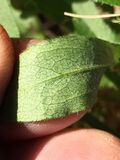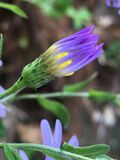Biology:Symphyotrichum patens
| Symphyotrichum patens | |
|---|---|

| |
| In Polkton, North Carolina | |
| Scientific classification | |
| Kingdom: | Plantae |
| Clade: | Tracheophytes |
| Clade: | Angiosperms |
| Clade: | Eudicots |
| Clade: | Asterids |
| Order: | Asterales |
| Family: | Asteraceae |
| Tribe: | Astereae |
| Subtribe: | Symphyotrichinae |
| Genus: | Symphyotrichum |
| Subgenus: | Symphyotrichum subg. Virgulus |
| Section: | Symphyotrichum sect. Patentes |
| Species: | S. patens
|
| Binomial name | |
| Symphyotrichum patens (Aiton) G.L.Nesom[2]
| |
| Varieties | |

| |
| County-level distribution map of Symphyotrichum patens[4] | |
| Synonyms[2] | |
|
Basionym
Alphabetical list
| |
Symphyotrichum patens, commonly known as late purple aster or spreading aster, is a perennial, herbaceous plant found in the eastern United States.[4][5]
Description
Sympyotrichum patens is a perennial and herbaceous flowering plant usually between 10 and 100 centimeters (1⁄4 and 3 1⁄4 feet) tall.[5] It has a spreading growth form, and the leaves are ovate to oblong and clasp the pubescent stem.[5][6] The flowers are relatively small, less than 3 centimeters (1 1⁄4 inches) in diameter, with light blue to violet ray florets and yellow disk florets. It flowers between August and October.[6]
Taxonomy
The title of a review of the Symphyotrichum patens complex begins with "Another review..." as a nod to the complexity of the topic.[3] The species was first formally described and named Aster patens by Swedish botanist Jonas Carlsson Dryander and published by Scottish botanist William Aiton in 1789.[7] It was transferred to the genus Symphyotrichum in 1995 by American botanist Guy L. Nesom.[8] It is closely related to Symphyotrichum georgianum and Symphyotrichum phlogifolium.[3]
Several varieties have been named, with the basionym as Symphyotrichum patens var. patens:
- Symphyotrichum patens var. gracile (Hook.) G.L.Nesom[2]
- Symphyotrichum patens var. patentissimum (Lindl.) G.L.Nesom[2]
- Symphyotrichum patens var. terranigrum J.J.N.Campb. & W.R.Seymour[3]
Distribution and habitat
A widely distributed species, S. patens ranges from southern Maine, south and west to eastern Texas .[4] Plants are typically found in sunny to mostly sunny sites, including open woodlands.[9]
Conservation
(As of July 2021), NatureServe listed Symphyotrichum patens as Secure (G5) worldwide and Possibly Extirpated (SX) in Maine.[1]
Citations
References
- Flora of North America Editorial Committee, ed. (2006), "Symphyotrichum patens" (in en), Flora of North America North of Mexico (FNA), 20, New York and Oxford, http://www.efloras.org/florataxon.aspx?flora_id=1&taxon_id=250067668, retrieved 23 December 2019
- Campbell, J.J.N.; Seymour, W.R. (Jr.) (1 December 2014). "Another review of the Symphyotrichum patens complex (Asteraceae), including a new variety of S. patens from the southern Blacklands, new records of S. georgianum, and notes on georgianum-like plants outside its known range" (in en). Phytoneuron (Fort Worth, Texas: Guy L. Nesom) 2014 (107): 1–33. ISSN 2153-733X. http://phytoneuron.net/2014Phytoneuron/107PhytoN-Symphyotrichumpatens.pdf. Retrieved 6 July 2021.
- "Aster patens [Dryand."]. International Plant Names Index (IPNI). Royal Botanic Gardens, Kew. https://www.ipni.org/n/181952-1.
- "Symphyotrichum patens (Aiton) G.L.Nesom". International Plant Names Index (IPNI). Royal Botanic Gardens, Kew. https://www.ipni.org/n/981873-1.
- "Symphyotrichum patens - Missouri Botanical Garden Plant Finder" (in en). St. Louis. n.d.. http://www.missouribotanicalgarden.org/PlantFinder/PlantFinderDetails.aspx?taxonid=292655&isprofile=0&=.
- "Symphyotrichum patens Late Purple Aster" (in en). Arlington, Virginia. 2 July 2021. https://explorer.natureserve.org/Taxon/ELEMENT_GLOBAL.2.138299/Symphyotrichum_patens.
- "Symphyotrichum patens" (in en). Raleigh: North Carolina Cooperative Extension Service. n.d.. https://plants.ces.ncsu.edu/plants/symphyotrichum-patens/.
- POWO (2019). "Symphyotrichum patens (Aiton) G.L.Nesom" (in en). Royal Botanic Gardens, Kew. http://www.plantsoftheworldonline.org/taxon/981873-1.
- "Symphyotrichum patens" (in en). Natural Resources Conservation Service PLANTS Database. USDA. 2014. https://plants.usda.gov/core/profile?symbol=SYPA11.
Wikidata ☰ {{{from}}} entry
 |







